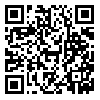Volume 16, Issue 6 (Feb 2023)
payavard 2023, 16(6): 515-525 |
Back to browse issues page
Ethics code: IR.SBMU.SME.REC.1401.153
Download citation:
BibTeX | RIS | EndNote | Medlars | ProCite | Reference Manager | RefWorks
Send citation to:



BibTeX | RIS | EndNote | Medlars | ProCite | Reference Manager | RefWorks
Send citation to:
Nahari R, Hashemzadeh S, Zarei E. The Impact of the Covid-19 Pandemic on Medical Tourism in Iran: An Interrupted Time Series Analysis. payavard 2023; 16 (6) :515-525
URL: http://payavard.tums.ac.ir/article-1-7336-en.html
URL: http://payavard.tums.ac.ir/article-1-7336-en.html
1- Master of Science in Health Services Management, Virtual School of Medical Education and Management, Shahid Beheshti University of Medical Sciences, Tehran, Iran
2- Ph.D. in Health Psychology, Shahid Mostafa Khomeini Hospital, Tehran, Iran
3- Assistant Professor, Department of Health Services Management, Virtual School of Medical Education and Management, Shahid Beheshti University of Medical Sciences, Tehran, Iran ,zareie@sbmu.ac.ir
2- Ph.D. in Health Psychology, Shahid Mostafa Khomeini Hospital, Tehran, Iran
3- Assistant Professor, Department of Health Services Management, Virtual School of Medical Education and Management, Shahid Beheshti University of Medical Sciences, Tehran, Iran ,
Abstract: (1093 Views)
Background and Aim: Medical tourism refers to travel for receiving health services abroad. The COVID-19 crisis affected a wide range of tourism-related businesses, including medical tourism, and caused a decrease in the supply and demand of health services in this market. This study aimed to investigate the impact of the COVID-19 pandemic on Medical Tourism in Iran.
Materials and Methods: This cross-sectional study was conducted in Iran in 2021. The data used in this study were extracted from the information system of the Ministry of Health from 2018 to 2021, which includes the number, origin, and destination of medical tourists, per capita revenue, and monthly revenue two years before and one and a half years after the COVID-19 pandemic. For data analysis, t-tests of independent groups and interrupted time series regression were used in SPSS and EViews 10 software.
Results: The COVID-19 pandemic has caused a 42% decrease in the average monthly number of medical tourists, a 45% decrease in the monthly revenue, and a 10% decrease in the per capita income per tourist (P<0.05). The arrival of medical tourists from the Republic of Azerbaijan, Bahrain, Iraq, and Oman has decreased by more than 80%, and the largest decrease in the number of tourists has been related to Ahvaz, Urmia, Tabriz, and Shiraz. In all diagnostic groups except obstetrics and gynecology, there has been a decrease between 50 to 70% The declining trend of medical tourism indicators was stopped in the second year of the COVID-19 pandemic and has continued as a constant trend.
Conclusion: The COVID-19 crisis has hurt the number of international patients and their revenue in Iran. Relative success in controlling COVID-19 can return to a pre-pandemic situation that requires appropriate policies and administrative measures by government and industry players, such as policies to facilitate patient entry, marketing measures, branding and creating a positive image of the country to potential clients, use of telemedicine facilities for consultations and follow-up, etc.
Materials and Methods: This cross-sectional study was conducted in Iran in 2021. The data used in this study were extracted from the information system of the Ministry of Health from 2018 to 2021, which includes the number, origin, and destination of medical tourists, per capita revenue, and monthly revenue two years before and one and a half years after the COVID-19 pandemic. For data analysis, t-tests of independent groups and interrupted time series regression were used in SPSS and EViews 10 software.
Results: The COVID-19 pandemic has caused a 42% decrease in the average monthly number of medical tourists, a 45% decrease in the monthly revenue, and a 10% decrease in the per capita income per tourist (P<0.05). The arrival of medical tourists from the Republic of Azerbaijan, Bahrain, Iraq, and Oman has decreased by more than 80%, and the largest decrease in the number of tourists has been related to Ahvaz, Urmia, Tabriz, and Shiraz. In all diagnostic groups except obstetrics and gynecology, there has been a decrease between 50 to 70% The declining trend of medical tourism indicators was stopped in the second year of the COVID-19 pandemic and has continued as a constant trend.
Conclusion: The COVID-19 crisis has hurt the number of international patients and their revenue in Iran. Relative success in controlling COVID-19 can return to a pre-pandemic situation that requires appropriate policies and administrative measures by government and industry players, such as policies to facilitate patient entry, marketing measures, branding and creating a positive image of the country to potential clients, use of telemedicine facilities for consultations and follow-up, etc.
Send email to the article author
| Rights and permissions | |
 |
This work is licensed under a Creative Commons Attribution-NonCommercial 4.0 International License. |






